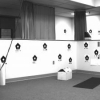Free Online Productivity Tools
i2Speak
i2Symbol
i2OCR
iTex2Img
iWeb2Print
iWeb2Shot
i2Type
iPdf2Split
iPdf2Merge
i2Bopomofo
i2Arabic
i2Style
i2Image
i2PDF
iLatex2Rtf
Sci2ools
109
Voted
CVPR
1999
IEEE
1999
IEEE
Robust Visual Servoing based on Relative Orientation
In this paper the problem of controlling the spatial position and orientation of a robotic platform based on the image data obtained from a video camera mounted on that platform is considered. More speci cally, we propose control laws that generate translational and angular velocities that will cause the robot to achieve and maintain a xed position and orientation with respect to a set of feature points in the scene. The proposed control schemes make use of well established techniques for computing estimates for the relative orientation of two camera positions from a set of feature correspondences. An important advantage of these control schemes is that it is possible to demonstrate analytically that they are globally convergent even in the presence of large calibration errors in both the intrinsic parameters of the camera and in the extrinsic parameters which relate the frame of reference of the camera to the body frame of the robot platform which is being controlled. Furthermore no ...
Camera Positions | Computer Vision | Control Schemes | CVPR 1999 | Relative Orientation | Robot Platform | Video Camera |
Related Content
| Added | 12 Oct 2009 |
| Updated | 30 Oct 2009 |
| Type | Conference |
| Year | 1999 |
| Where | CVPR |
| Authors | Camillo J. Taylor, James P. Ostrowski, Sang-Hack Jung |
Comments (0)

